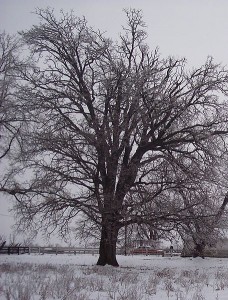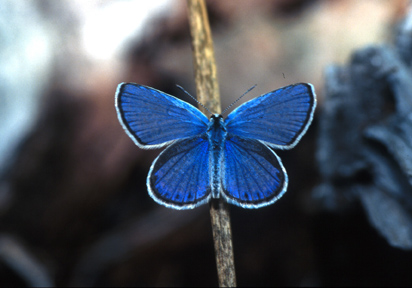Last weekend, I got to participate in an oak savanna restoration with Gary Werner and some Ice Age Trail volunteers. The goal was sort of to “weed out” undesirable trees and shrubs like box elder and hateful, invasive buckthorn so that any future controlled burns of the area wouldn’t be able to spread out of control. Several sawyers – guys with chainsaws and specific gear and training – took down a couple dozen trees. Every few minutes, we’d all stop what we were doing to watch as another tree fell. Then we sliced and diced each tree into pieces big enough to carry. We dragged them to one of two gigantic brush piles that took turns smoldering and blazing over our heads.
The location was the Table Bluff segment of the Ice Age Trail. The trail goes through an oak savanna/prairie that was planted around fifteen years ago on the front end of the property. It looks great. The old oaks are thriving, and the young ones, mostly Bur Oaks, stand over six feet tall. That’s a grand accomplishment with all the deer in the area that love the tender shoots of baby oak trees.
Bur oaks can live for 300-400 years, according to an article by Marlin Johnson published in Mammoth Tales in 1996 (one of the many pieces I am cataloging as part of my work with the Ice Age Trail Alliance). They weather fire well: full-grown Bur oaks have heat-resistant bark, and the seedlings don’t die when they are engulfed in flames. Instead, the stems burn but the root system becomes stronger. Johnson writes,
Indeed, many early Wisconsin settlers broke their plowshare trying to cut the bond between these brushy oaks and the prairie sod. Much to the pioneers’ chagrin, they discovered that three-foot-tall oak brush grew atop 100- to 200-year-old stumps hidden deep underground.
Why not leave the woods around the trail as they are? you may ask. Good question.
The function of prairie and oak savanna restorations, as far as I understand it, is twofold. First, as native plant communities, they represent a biodiversity that vanishes in development and sprawl. Prairies in Wisconsin harbor the federally endangered Karner Blue Butterfly as other landscapes cannot do.
I did a report on these little guys in about second grade, I think. Their larvae eat only lupine, a plant native to the Wisconsin prairies. As the prairies have dwindled, so has the butterfly. Of its old stomping (fluttering?) grounds from New Hampshire to Minnesota, only a few havens remain in Michigan, New York, and our very own Wisconsin. My home state, Indiana, no longer sees much of it, sadly. So there’s an example of the need for such biodiversity in habitat.

The second reason for these restorations is interpretive. Part of the vision of the Ice Age Trail Alliance is that the trail be
a continuous footpath through diverse landscapes that
- Provides a natural corridor that protects habitat and enables the movement of wildlife;
- Serves as a lifelong educational resource;…and
- Links the history and diverse human cultures of the land that we call Wisconsin.
Restoring land in the trail corridor and in its viewshed to its pre-settlement state makes hiking the Trail an educational experience. Hikers get to see what Wisconsin looked like before the farms, before the highways, before the houses. That knowledge, I think, makes people feel closer to the land they live on, and maybe it makes us more aware of our impacts on it. But not only that – seeing native landscapes allows us to imagine the ways that glaciation affected the lay of the land. When prairie grasses and Bur oaks sway gently on the back of an esker, we can see how well that ridge of sand and gravel, created as silty streams flowed out of the melting glacier, plays host to exactly the kind of habitat where Karner Blue Butterflies flourish.
If you want to participate in the work the Ice Age Trail is doing, become a member.
Habitat restoration on the Ice Age Trail is only one of the many ways that one can steward the land. For your personal entertainment and edification, here are two fantastic songs by a fantastic band called Jayber Crow. One’s about another heat-resistant tree species, the Jack Pine, which actually needs fire in order for its seeds to germinate.
The other is a love song for a prairie fire.
Enjoy!


#1 by Joanne Ellarson on March 13, 2010 - 11:27 am
Great story! And the burn season is here! We will do what we can for these fire dependent species. The Karner Blue Butterfly is such a beautiful little thing.
I have loved the prairie fire as long as I have been aware of the need and have been able to take part in making them happen.